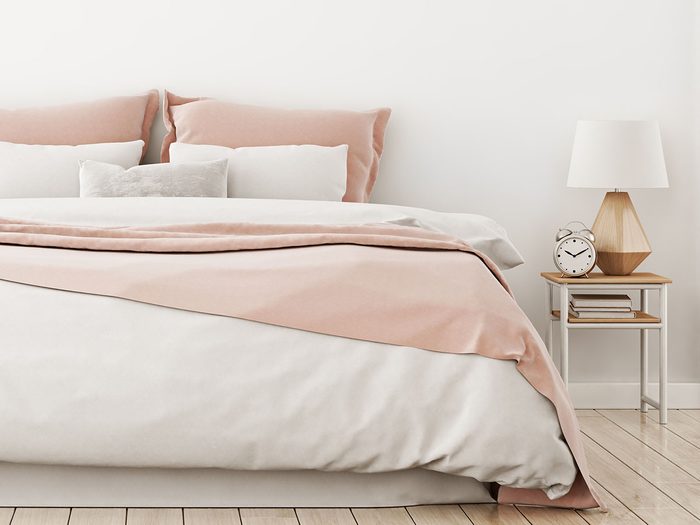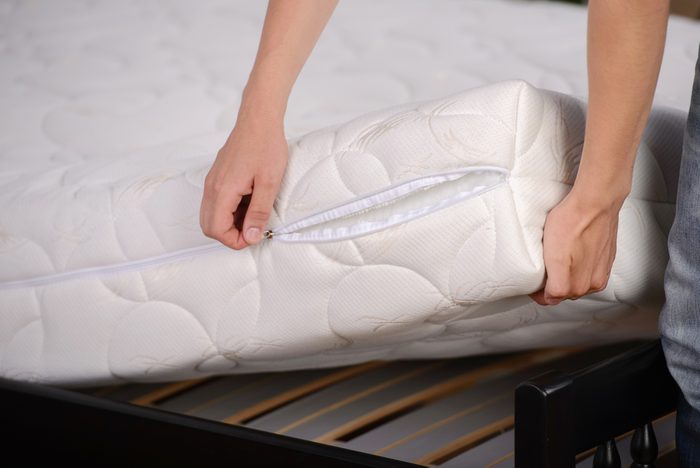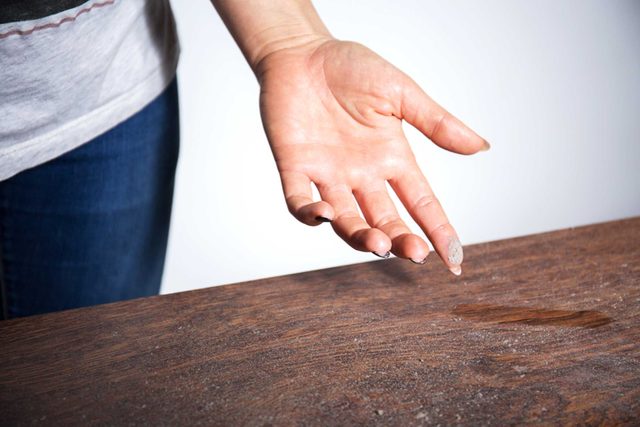
Is pollution invading your bedroom?
Most people think about pollution as an outdoor problem that they can escape when they go inside, but indoor pollution may be even more dangerous and pervasive. And it doesn’t help that, due to the coronavirus, we’re spending more time indoors. The concentrations of some pollutants can be up to five times higher than what you’d typically be exposed to outside. While this can be an issue in any room, bedrooms can be particularly concerning because we spend so much time there.
The bedroom can be a significant source of air pollution, says Kimberly Button, who is a certified consultant with the International Well Being Building Institute. She also founded the website Get Green Be Well and created The Ultimate Home Detox Guide. She advises reducing—as much as possible—the potential toxins and allergens in your bedroom.
Also, check out the ways toxins are sneaking in your entire home.

Paint
That fresh coat of paint on your bedroom walls could cause some serious health problems. Some paints and related products emit volatile organic compounds (VOCs) that can affect you for longer than the painting and drying period. Research published in 2019 in the International Journal of Scientific Research and Review indicates that paint can be a major source of VOCs in the home. Other findings have suggested that young children exposed to high concentrations of these paint fumes and common cleaners had higher rates of asthma, eczema, and allergies. VOCs also have been linked to organ damage and cancer, reports the American Lung Association. To minimize risk, make sure to paint in well-ventilated conditions, allow for a significant drying and airing-out period, and opt for low- or zero-VOC paint. Look into your eco-paint options.

Mattresses
A mattress filled with toxic chemicals could put a serious damper on your rest and health. Some mattress hazards include flame-retardant chemicals and PVC, both of which have been linked to certain types of cancer and hormone disruption. While being around these toxins can be dangerous for anyone, children are particularly vulnerable since they can spend up to 14 hours per day sleeping, says Jane McElroy, PhD, a family and community medicine professor at the University of Missouri School of Medicine. “Children and infants are at greater risk from environmental toxins because their bodies and their ability to handle exposure to toxins are still developing,” she adds. “Further, numerous detrimental health and developmental outcomes for children have been linked to VOC exposure.” Look for Global Organic Textile Standard (GOTS) certification when buying to help you avoid VOCs and fire retardants. Learn what else can happen when you sleep on an old mattress.

Pillows
“All bedding can emit VOCs—it’s not just beds,” warns Button. “If you have a pillow made from memory foam, it’s just as problematic with off-gassing chemicals as a mattress made with memory foam.” Plus, your nose is just inches away from the source of the problem for hours at a time. Button adds that while off-gassing is generally the strongest in the first few weeks and months after buying a new product, it doesn’t ever completely stop.
Mold, dust mites, and other allergens can also accumulate in your favourite pillow. “We all tend to hold onto bedding way longer than it’s healthy to do so—sometimes people have had the same pillow for more than 10 years,” Button says. “Dust mites can build up and create serious allergic problems that you might be blaming on something else.” She suggests choosing a material that’s resistant to dust mites, such as natural latex, or a natural material like wool. While it may be a bit more expensive than synthetic options, it can prevent health problems and save you much more in the long run.

Toiletries
You might not think twice about the perfumes, powders, polishes, and assorted cosmetics that likely top your dresser (or the counters in your bathroom), but if you have small children, that’s a mistake. Personal-care products—which may contain alcohol or other chemicals not meant to be ingested or put near the eyes—were responsible for the most child-related calls to poison-control centers in 2017 for children under the age of five.
Johns Hopkins Medicine notes that the hours between 4 p.m. and 10 p.m. are the most common times for this to happen because parents aren’t watching kids as closely while they’re making dinner or tending to other issues around the house. Poison-centre workers refer to late afternoon as “the arsenic hour.” Make sure to keep products out of reach or behind cabinets, always keep a watchful eye on little ones, and, of course, call 911 or poison control if your child has ingested a possible toxin. Learn more about the toxic ingredients in your beauty products.

Dressers, bookcases, and other wood furniture
The problem here lies mostly with engineered wood or composite wood products—namely, hardwood plywood, medium-density fibreboard, and particleboard, according to the EPA. These products are typically bound together with adhesives that contain formaldehyde, which can cause breathing problems and irritate eyes, as well as potentially cause cancer. Those at particular risk include infants and other young children, the elderly, and people with asthma or other respiratory problems.
The Agency for Toxic Substances and Disease Registry suggests looking for furniture with low or no formaldehyde, or a label that says, “No VOC/Low VOC.” The EPA also recently instituted new rules regarding composite wood, making sure that they meet formaldehyde-emission standards, but older items are still in circulation.

Mothballs
These tiny little balls that protect your clothing pack a big chemical punch—and not just for the insects and rodents they’re meant to repel. According to the National Pesticide Information Center, they’re comprised of almost 100 percent of their active ingredient, either naphthalene or paradichlorobenzene, and they eventually turn from solid balls into toxic vapors.
If you’re smelling their distinctive smell, you’re inhaling toxins. That can cause headaches, dizziness, eye, and skin irritation, and, in the long run, even cataract formation and liver damage. To prevent this, make sure to read—and abide by—the directions. Proper usage generally entails putting the mothballs in an airtight container.

Upholstered furniture
There’s a good chance that the foam in your upholstered furniture contains organohalogen flame retardants (OFRs). These chemicals, which the Consumer Product Safety Commission has recommended that consumers avoid, have been linked to a slew of health problems, including cancer, reproductive problems, hormone dysfunction, and, in children, low IQ, hyperactivity, and learning issues. (Recent research also suggests that these materials aren’t even that effective at combating fire.) In a study of 857 participants by Duke researchers, OFRs were found in more than 90 percent of adults and children. One problem is that these chemicals can seep out of furniture and into the environment, where they can be touched, inhaled, or swallowed. While some states are banning these chemicals in furniture production, you should always check a product’s label.

Carpets
That lush, cushy carpet under your feet may cause multiple health problems. A review of research published in the International Journal of Environmental Research and Public Health shows that carpeted floors have been linked to respiratory irritation and infections, asthma, headaches, and fatigue. It’s not clear, however, what’s causing these conditions. One likely culprit: VOC emissions from synthetic fibres, adhesives, padding, and chemical treatments. But there’s more to it than that. “The issue with wall-to-wall carpets goes beyond the off-gassing of VOCs—they are a sink of pollutants that remain in the home,” says McElroy. “Carpets collect dust, allergens, and pollutants, and these can also be re-suspended with vacuuming and even by walking or playing on them.”
Cleaning products can also accumulate in the fibres of the rug. If you have your heart set on a carpet, the EWG recommends choosing one with more natural and sustainable fibres, such as wool, using certified low-VOC adhesives, letting it air out sufficiently when installed, taking off shoes when inside, and using a vacuum with a HEPA filter.

Air fresheners
Phthalates are the worrisome ingredients in many air fresheners. They have been linked to hormonal disruption, birth defects, and reproductive issues, and one study published in Environmental Health Perspectives found that pregnant women exposed to phthalates had a higher likelihood of having children who developed asthma. According to research conducted by the Natural Resources Defense Council, even though many air fresheners don’t list phthalates in their ingredients, they are often still there—even in those labeled “all-natural” or “unscented.”
Button says the key is to look for a product made with essential oils, which are distilled parts of actual plants that retain the fragrance naturally. But be careful, she says. “A lot of marketing claims say ‘made with essential oils,’ and even if they only use 1 percent essential oils and the rest artificial fragrance, they’re not lying in their claim. You want a room spray or linen spray that says ‘fragrance from 100 percent essential oils’ or ‘only from essential oils.'”

Scented candles
When something burns, you breathe in the smoke and particulate matter that it releases. This may be particularly problematic with scented candles, where you’re likely adding VOCs and other chemicals to the mix. (In fact, candle smoke could be as bad for you as cigarette smoke.) “Several toxic chemicals and airborne particles from [scented candles and other fragranced products] have been linked to adverse health effects, such as respiratory issues, migraine headaches, and contact dermatitis,” says McElroy. “Avoiding exposure to these toxins by not using items that emit fragrances is the best solution. Well-ventilated areas will also reduce the exposure. The old-fashioned solution of airing out the room by opening windows does help.”

Cleaning products
Cleaning is obviously a good thing, but the chemicals that we use may not be. Many common cleaning products contain a variety of chemicals, including VOCs, as well as fragrances. Chlorine bleach and ammonia, for example, can release chemicals into the air that can aggravate allergies and asthma. The American Lung Association also warns that those two items should never be mixed since they can create gases that can cause chronic breathing problems and even death.
Button suggests using products made with plant-based or natural ingredients, noting that it isn’t necessary to use heavy-duty chemical-based cleaners for everyday cleaning. “And never underestimate the simple cleaning power of soap and water,” she adds. “It’s what we use to wash germs off our hands, and it does the same for items in the home, such as floors, toilets, and countertops.” Here are three natural cleaning products that are good for the environment.

Dust
While the dust on top of your dresser and the dust bunnies underneath it aren’t bedroom items, per se, they can take up semi-permanent residence in your room. According to a study published in Environmental Science & Technology, researchers found 45 toxic chemicals in house dust. Two the most common were phthalates and flame retardants, and all of the chemicals generally came from common items such as flooring and carpets, blinds, fragrances, treatments for upholstery and clothes, and personal-care products. While this can pose a danger to anyone, young children are at the most risk since they crawl on the floor, touching everything and then touching their mouths.
Instead of simply dusting, try using a vacuum with a HEPA filter, and remember to wash your kids’ hands regularly, even when at home—and wash your own as well.
Next, check out everything you should clean in the next 30 days.
